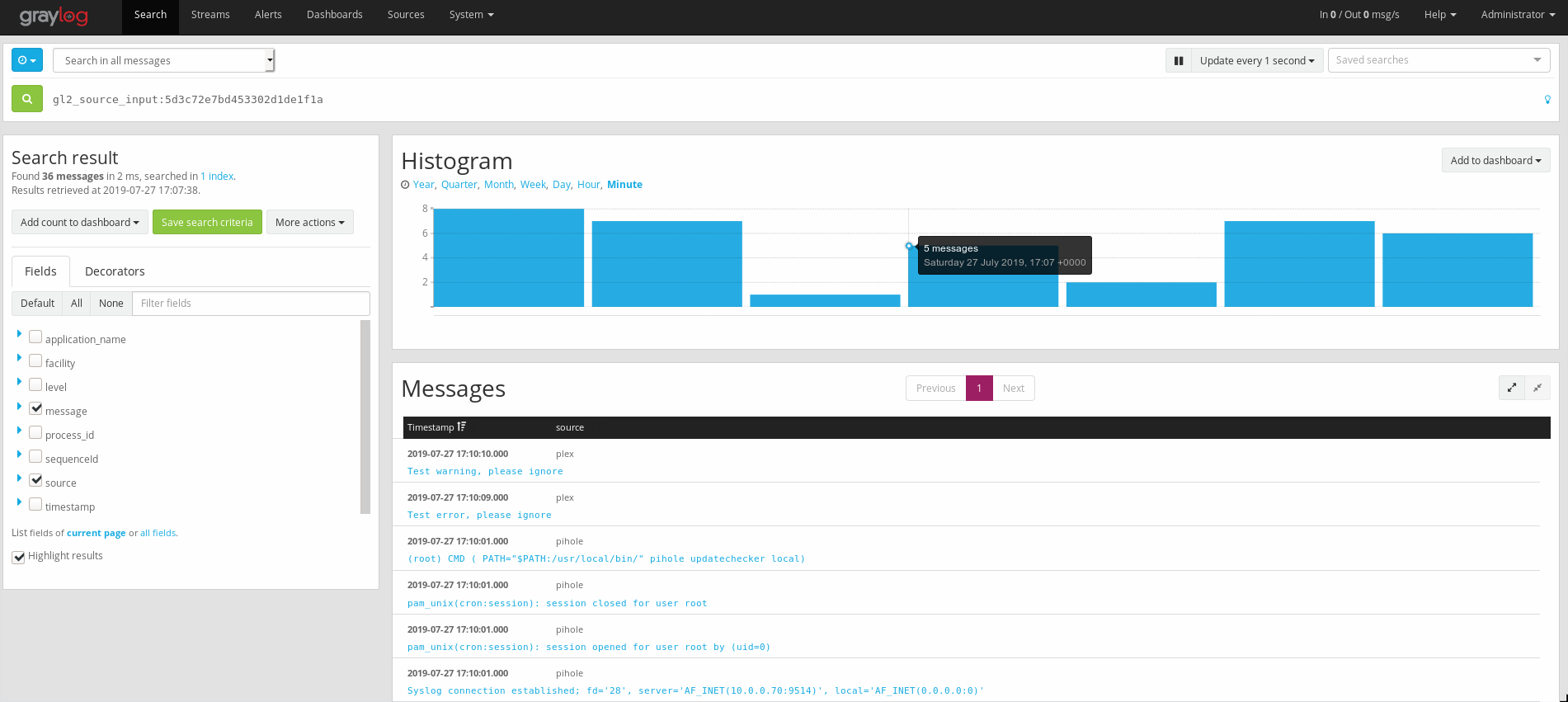I’ve wanted to set up scalable central logging for my home servers for a while now, and Graylog looks like a pretty good tool. At the same time, I’ve been wanting to learn how Ansible works for a while, and this looks like a good opportunity to do so!
Install Ansible
First step is to get Ansible setup and working:
sudo pacman -Syu && sudo pacman -S ansible
Setup ansible inventory, grouping hosts that will belong to the graylog_client group to speed the client setup later on.
nano /etc/ansible/hosts
Using the YAML format as a personal preference
all:
hosts:
ma.ax:
children:
ubuntu_servers:
hosts:
pihole.ma.ax:
graylog.ma.ax:
plex.ma.ax:
yosemite.ma.ax:
graylog_clients:
hosts:
pihole.ma.ax:
plex.ma.ax:
yosemite.ma.ax:
Check the Ansible setup, all hosts should appear green:
max@huez ~ % ansible all -m ping
pihole.ma.ax | SUCCESS => {
"ansible_facts": {
"discovered_interpreter_python": "/usr/bin/python3"
},
"changed": false,
"ping": "pong"
}
....
Setup a VM on Proxmox
Setup a simple VM, 2 CPU cores, 4GB ram, 20GB HDD space running Ubuntu Server 18.04.2 LTS.
Update the VM and install qemu-guest-tools before doing anything on it.
sudo apt update && sudo apt install qemu-guest-tools && sudo apt dist-upgrade
Setup the Graylog server
There’s a pretty comprehensive Ansible playbook available on the Graylog github here. So following that, the server Ansible playbook is:
- hosts: "all"
remote_user: "max"
become: True
vars:
es_enable_xpack: False
es_instance_name: "graylog"
es_heap_size: "1g"
es_config:
node.name: "graylog"
cluster.name: "graylog"
http.port: 9200
transport.tcp.port: 9300
network.host: "127.0.0.1"
graylog_install_java: False # Elasticsearch role already installed Java
graylog_password_secret: "*" # generate with: pwgen -s 96 1
graylog_root_password_sha2: "*"
graylog_http_bind_address: ":9000"
graylog_http_publish_uri: "http://:9000/"
graylog_http_external_uri: "http://:9000/"
roles:
- role: "Graylog2.graylog-ansible-role"
tags:
- "graylog"
Install the Graylog role, and the dependencies:
ansible-galaxy install -n -p ./roles Graylog2.graylog-ansible-role
ansible-galaxy install -r roles/Graylog2.graylog-ansible-role/requirements.yml -p ./roles
Setup the VM, specifiying the hostname and adding the “-K” flag to prompt for the sudoer password
ansible-playbook server.yml -K -i "graylog.ma.ax,"
Setup Graylog input source
To receive logs, new input sources must be defined. From the Graylog web GUI head over to System -> Input sources. Define the input source as Syslog TCP with the port changed to 9514. I am using port 9514, rather than the default 514 to avoid the privileged execution that is required for ports < 1024.

Setup the Graylog clients
Next step is to configure the clients to forward their syslog entries to the server, again there’s a good and simple guide here. I’ll make a short playbook to automate this for the ‘graylog_clients’ host group.
---
- hosts: graylog_clients
become: yes
tasks:
- name: install syslog-ng
apt:
name: syslog-ng
- name: copy graylog syslog-ng configuration to client
copy:
src: ./graylog.conf
dest: /etc/syslog-ng/conf.d/
owner: root
group: root
mode: '0644'
- name: restart syslog-ng
service:
name: syslog-ng
state: restarted
This installs syslog-ng, copies the config file over, and reloads syslog-ng so the new config is loaded. The graylog.conf is as follows:
# Define TCP syslog destination.
destination d_net {
syslog("graylog.ma.ax" port(9514));
};
# Tell syslog-ng to send data from source s_src to the newly defined syslog destination.
log {
source(s_src); # Defined in the default syslog-ng configuration.
destination(d_net);
};
Run the playbook on the clients:
ansible-playbook client.yml -K
Check if it works
Head back over to System -> Inputs on the Graylog web GUI, click on the “Show received messages” which will direct to a search constrained by the input source. I adjusted my update time to be 1 second on the top of the page, as I only have a couple of log sources.
Generate syslogs if you need too:
logger -p error Test error, please ignore
logger -p warn Test warning, please ignore

It works!
Error checking
If no logs are coming through, check the client and server side logs.
Client syslogs:
tail -f /var/log/syslog
Graylog server logs:
tail -f /var/log/graylog-server/server.log